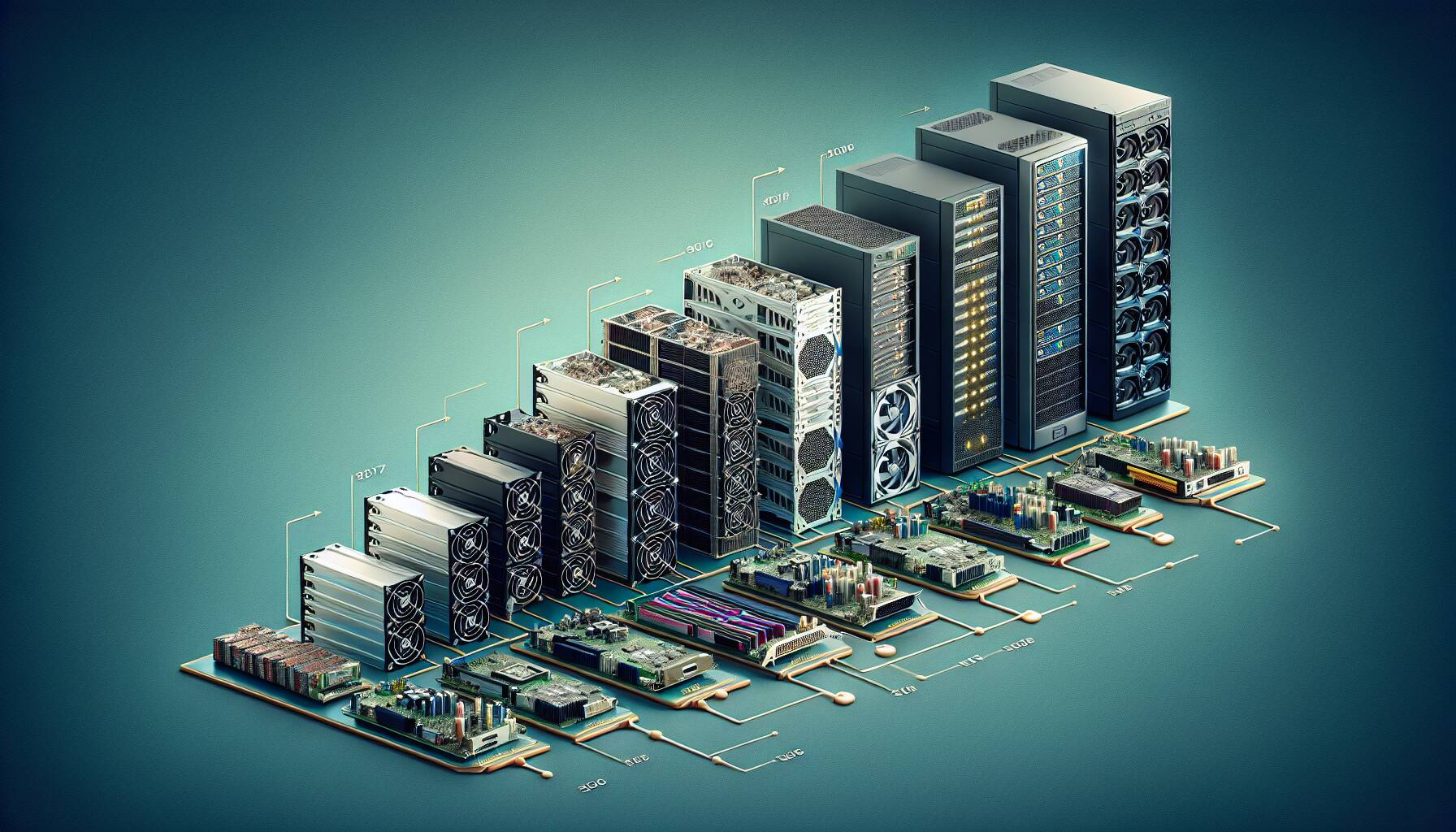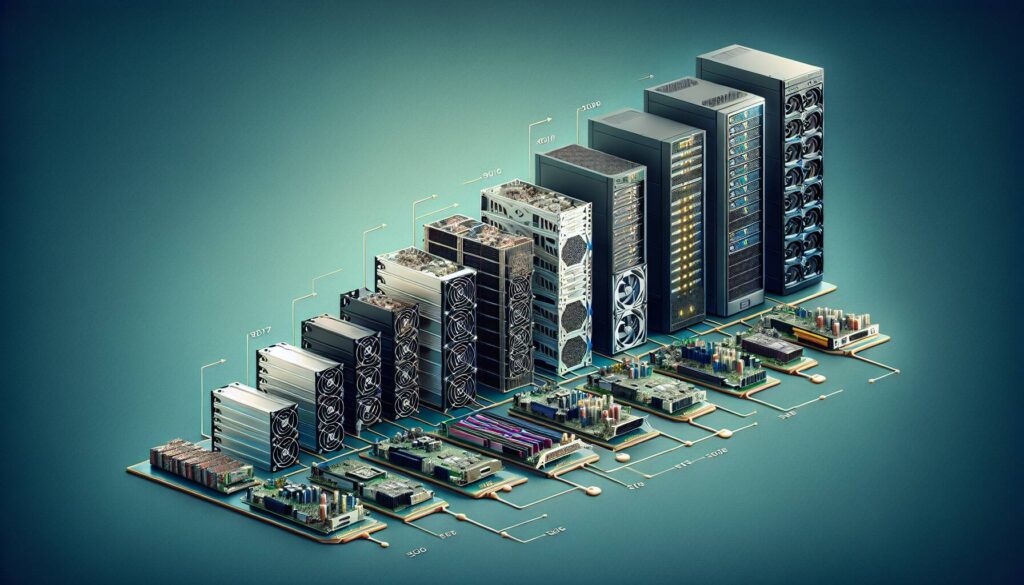The cryptocurrency industry is witnessing a significant evolution in the design of Bitcoin mining hardware, shifting from the traditional “shoebox” models to more server-like configurations. This transformation, marked by advancements in cooling technologies and efficiency gains, is heralding a new era for miners looking to optimize operations and adapt to emerging technological landscapes.
In recent developments, ASIC (Application-Specific Integrated Circuit) manufacturers are diverging from the conventional designs that have dominated the scene since the advent of Bitcoin mining. Notably, companies like Bitmain, MicroBT, and Auradine are introducing newer models that fit into standard data center frameworks, aligning more closely with conventional computing architectures. The focus is primarily on hydro-cooled server racks, which not only promise enhanced cooling performance but also boast higher efficiency—a critical factor as energy costs and environmental considerations increasingly impact mining profitability.
“Based upon a lot of feedback that we got from our miner customers … we’ve been working with the miners even throughout the design process,” said Auradine’s CSO Sanjay Gupta, highlighting the responsiveness of manufacturers to evolving market demands.
These new configurations are seen as offering several operational advantages. For one, they cater to the preferences of miners who are seeking streamlined, standardized setups that resemble those found in larger data centers. Such a paradigm shift could significantly ease the challenges associated with building and maintaining mining infrastructures, especially as the demand for more versatile computing capabilities, including AI and high-performance computing (HPC), grows.
The strategic push towards designs like Bitmain’s U3S21EXPH and Auradine’s AH3880 reflects a commitment to meeting market needs while also facilitating potential future transitions to AI workloads. The compatibility of these designs with HPC architecture can allow for easier retrofitting of mining sites for these emerging applications, creating a dual-path opportunity for miners.
“The U form factor … is compatible with HPC style architecture,” explained Sue Ennis, Head of Investor Relations at Hut 8, emphasizing the broader implications for technological integration.
However, the transition to this innovative setup is not without its challenges. Existing miners may need to overhaul their electrical infrastructures to accommodate the specific requirements of these new models. This is a significant undertaking that could limit immediate adoption to new mining sites, as transitioning existing operations poses logistical hurdles and costs.
As the sector explores these promising developments, the path forward remains uncertain. Mining companies are cautiously optimistic, with early adopters like Hut 8 planning substantial implementations of new technologies. If the performance of these new systems meets expectations, the ripple effects could very well reshape the future of Bitcoin mining, opening doors to efficiency and adaptability in an ever-evolving market landscape.

Future of Bitcoin Mining: The Shift to Server Rack Designs
The article outlines significant trends in bitcoin mining technology, particularly the transition from traditional shoebox ASIC designs to more efficient server rack models. Here are the key points:
- Shift in Mining Equipment Design:
- Emergence of ASICs in 2013 marked a turning point in mining technology.
- New designs like server racks offer increased efficiency and better integration with existing data center technologies.
- Hydro-Cooling and Direct Liquid Cooling:
- Companies like Bitmain and Auradine are focusing on hydro cooling to enhance miner performance.
- Direct-to-chip cooling could lead to significant efficiency gains in power usage and heat management.
- Customer-Driven Design:
- Recent designs, such as Auradine’s AH3880, were influenced by feedback from miners, highlighting the importance of adapting to customer needs.
- Collaboration between ASIC manufacturers and mining firms promotes innovation.
- Standardization with Data Center Practices:
- Server rack designs align closely with standards in traditional datacenter architecture, which could simplify operations for bitcoin miners.
- Embracing server standards may lead to easier scalability and flexibility for miners wishing to enter AI or HPC markets.
- Potential Adoption Challenges:
- Existing mining infrastructure may not support new models due to voltage compatibility issues.
- The shift may predominantly occur at new mining sites, as retrofitting existing operations poses logistical challenges.
- Market Dynamics:
- Public mining companies like Hut 8 are taking early steps in adopting new technologies, which could set trends for the broader industry.
- Success in these implementations may encourage other miners to follow suit.
“The U form factor is compatible with HPC style architecture […] it is extremely relevant for AI data centers.” – Sanjay Gupta, Auradine CSO
These developments are important as they may reshape the landscape of bitcoin mining, potentially impacting profitability, operational efficiency, and the future viability of mining companies as they navigate the evolving tech landscape.
The Future of Bitcoin Mining: A Shift from Shoebox to Server Rack Designs
The Bitcoin mining landscape is witnessing a significant transformation with the emergence of server rack ASIC designs, which are aiming to replace the traditional shoebox form factor that has dominated the industry since the introduction of ASIC miners in 2013. While ASIC manufacturers like Bitmain and Auradine are betting on this new design for enhanced performance and efficiency, the transition brings both opportunities and challenges that could reshape the competitive dynamics within the sector.
Competitive Advantages: Streamlined Integration and Efficiency Gains
The principal advantage of adopting server rack configurations is the potential for standardization across Bitcoin mining operations. Adapting designs used in traditional data centers not only facilitates a smoother integration for miners who want to diversify their computing capabilities but also optimizes supply chains, reducing operational complexity. As the demand for direct-to-chip cooling solutions rises, it’s anticipated that a noteworthy 40% of Bitcoin mining operations will employ this method by 2026, enhancing the efficiency of power usage and thermal management.
Strategic Positioning with AI and HPC
The compatibility of server rack designs with high-performance computing (HPC) paves the way for a dual-purpose infrastructure that could cater to the growing demands of AI workloads. This cross-functionality can be a game changer for miners looking to pivot towards lucrative AI applications while still maintaining their cryptocurrency operations. The ability to adapt existing infrastructures for both Bitcoin mining and AI processing could position early adopters advantageously in a rapidly evolving tech landscape.
Competitive Disadvantages: Infrastructure Challenges and Adoption Hurdles
However, the transition isn’t without its drawbacks. Existing Bitcoin mines may face substantial infrastructure changes that could deter miners from integrating new server rack systems. Brad Cuddy’s concerns regarding voltage compatibility highlight the potential logistical complications that could arise when trying to retrofit older operations to accommodate new technology. The limited voltage range of certain models like the U3S21EXPH presents interoperability issues, making it less appealing for miners with established setups.
Target Audience and Stakeholder Impact
As it stands, this new wave of mining machinery primarily benefits miners establishing new operations, providing them with the latest technologies from the inception. Public miners like Hut 8 and potential partners such as Marathon Digital Holdings (MARA) could leverage these advancements to enhance their operational efficiencies and position themselves as leaders in the evolving space. On the other hand, existing miners committed to older systems may find themselves at a competitive disadvantage, potentially struggling to keep pace with innovations that elevate the cost-effectiveness of new entrants adhering to emerging standards.
As this evolution continues, the landscape appears ripe for further developments, and the implications of these design shifts will undoubtedly continue to unfold, carving a new path for the future of Bitcoin mining.

















